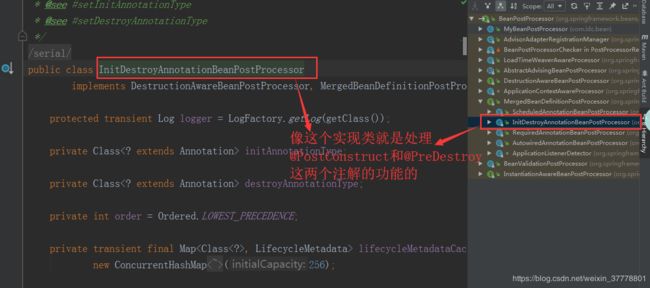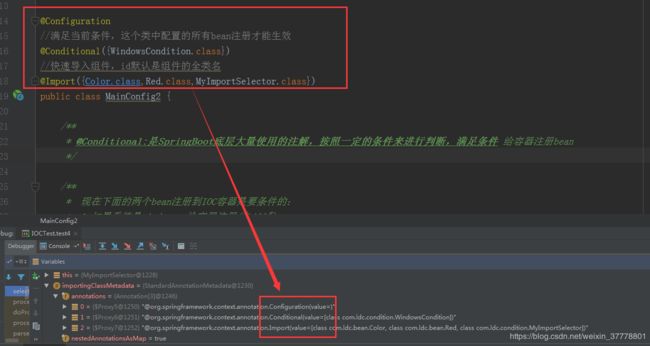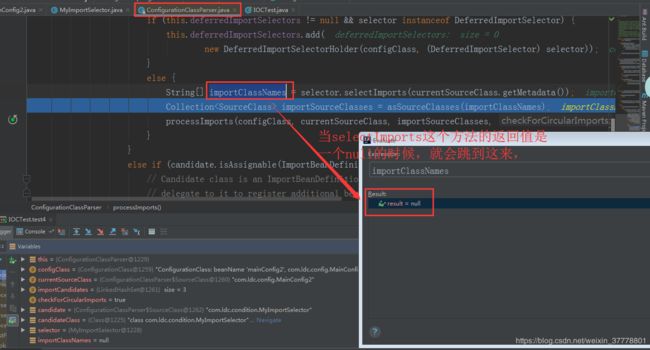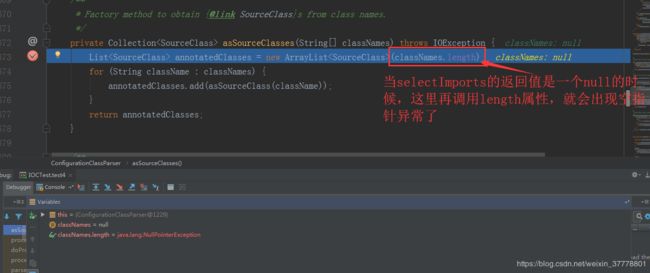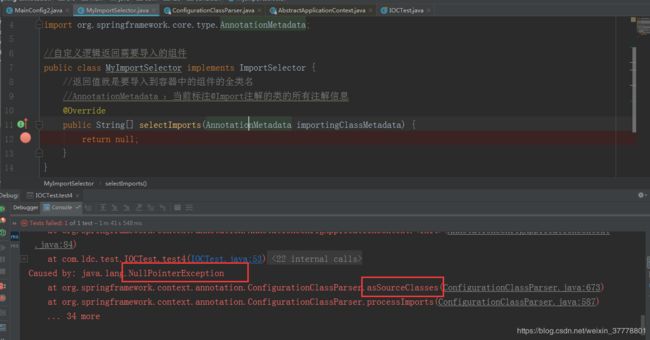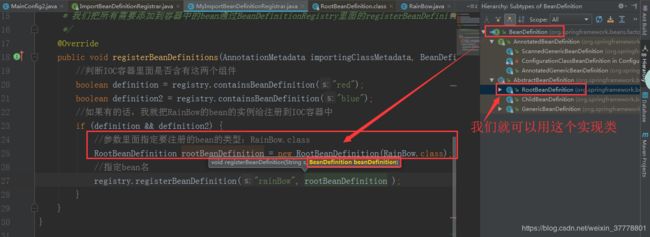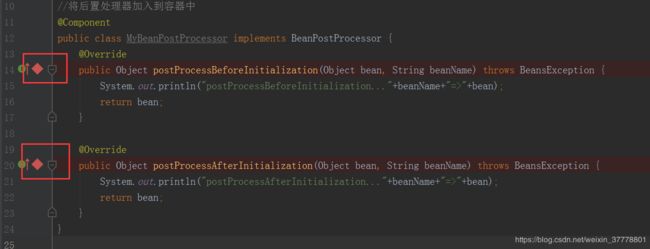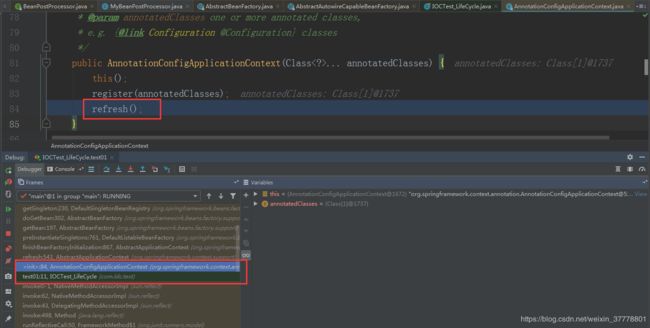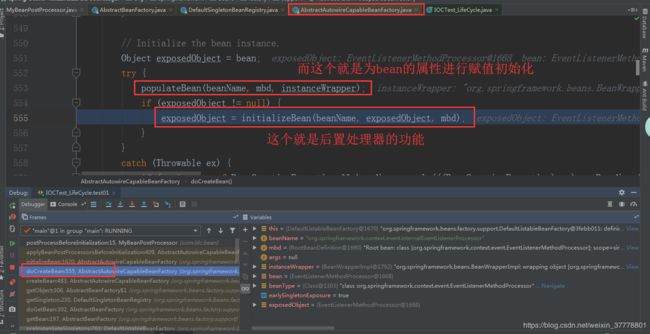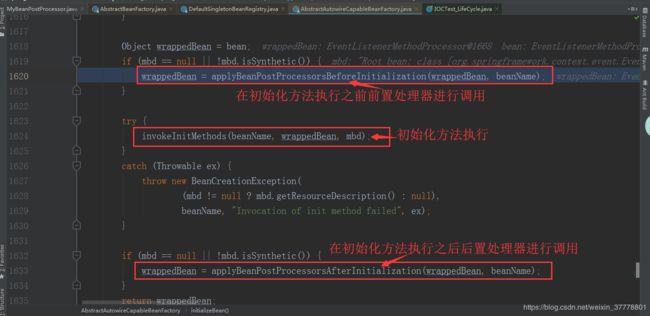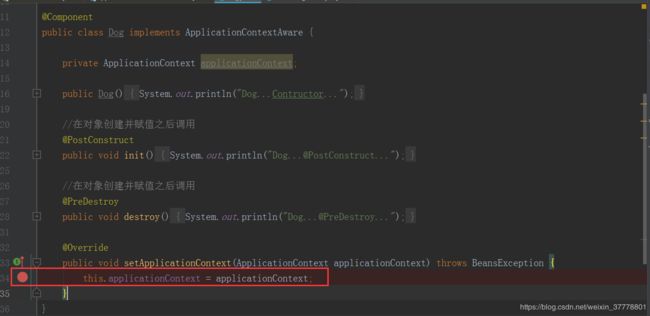Spring注解驱动开发(二)
Spring注解驱动开发(二)
- 组件注册-`@Lazy-bean`懒加载
- 组件注册-`@Conditional`-按照条件注册bean
- 组件注册-`@Import`-给容器中快速导入一个组件
- 组件注册-`@Import`-使用`ImportSelector`
- 组件注册- `@Import`-使用`ImportBeanDefinitionRegistrar`
- 组件注册-使用FactoryBean注册组件
- 生命周期-`@Bean`指定初始化和销毁方法
- 生命周期-`InitializingBean`和`DisposableBean`
- 生命周期- `@PostConstruct`&`@PreDestroy`
- 生命周期-`BeanPostProcessor`-后置处理器
- 生命周期-`BeanPostProcessor`原理
- 生命周期- `BeanPostProcessor`在Spring底层的使用
组件注册-@Lazy-bean懒加载
- 懒加载:是专门针对于单实例的bean的
- 单实例的bean:默认是在容器启动的时候创建对象;
- 懒加载:容器启动的时候,不创建对象,而是在第一次使用(获取)Bean的时候来创建对象,并进行初始化
当我们还没有配置懒加载的时候:作用域为单例的bean,默认是在容器启动的时候创建实例对象
@Configuration
public class MainConfig2 {
/**
* 懒加载:是专门针对于单实例的bean的
* 1.单实例的bean:默认是在容器启动的时候创建对象;
* 2.懒加载:容器启动的时候,不创建对象,而是在第一次使用(获取)Bean的时候来创建对象,并进行初始化
* @return
*/
@Bean("person")
public Person person() {
System.out.println("给IOC容器中添加Person...");
return new Person();
}
}
测试:
@Test
public void test02() {
ApplicationContext applicationContext = new AnnotationConfigApplicationContext(MainConfig2.class);
System.out.println("IOC容器创建完成...");
}
测试结果:
给IOC容器中添加Person…
IOC容器创建完成…
从上面的测试结果,我们可以看出:作用域为单例的bean,默认是在容器启动的时候创建实例对象
而现在,我加上懒加载的注解:@Lazy
@Configuration
public class MainConfig2 {
/**
* 懒加载:是专门针对于单实例的bean的
* 1.单实例的bean:默认是在容器启动的时候创建对象;
* 2.懒加载:容器启动的时候,不创建对象,而是在第一次使用(获取)Bean的时候来创建对象,并进行初始化
* @return
*/
@Lazy
@Bean("person")
public Person person() {
System.out.println("给IOC容器中添加Person...");
return new Person();
}
}
我们再来运行以下的测试方法:
@Test
public void test02() {
ApplicationContext applicationContext = new AnnotationConfigApplicationContext(MainConfig2.class);
System.out.println("IOC容器创建完成...");
}
这个时候,运行结果如下:
IOC容器创建完成…
我们可以看到,这个时候,只有IOC容器启动了,而作用域为单例的bean并没有被创建;
而当我们第一次获取的时候,我们再来看看运行结果:
@Test
public void test02() {
ApplicationContext applicationContext = new AnnotationConfigApplicationContext(MainConfig2.class);
System.out.println("IOC容器创建完成...");
Person person = (Person) applicationContext.getBean("person");
}
运行结果:
IOC容器创建完成…
给IOC容器中添加Person…
从运行结果,我们可以看到,当我们调用了getBean()方法获取的时候,bean的实例对象才会被创建;而且只会被创建一次;作用域还是单实例的!
组件注册-@Conditional-按照条件注册bean
现在有两个bean: bill 和 linus ,现在我们想按照操作系统的不同来选择是否在IOC容器里面注册bean:
现在下面的两个bean注册到IOC容器是要条件的:
1.如果系统是windows,给容器注册(“bill”)
1.如果系统是linux,给容器注册(“linus”)
@Configuration
public class MainConfig2 {
/**
* @Conditional:是SpringBoot底层大量使用的注解,按照一定的条件来进行判断,满足条件 给容器注册bean
*/
/**
* 现在下面的两个bean注册到IOC容器是要条件的:
* 1.如果系统是windows,给容器注册("bill")
* 1.如果系统是linux,给容器注册("linus")
* @return
*/
@Bean("bill")
public Person person01() {
return new Person("Bill Gates",62);
}
@Bean("linus")
public Person person02() {
return new Person("linus",48);
}
}
我们可以看到这个注解:value值传的是实现了Condition这个接口的类的数组
@Target({ElementType.TYPE, ElementType.METHOD})
@Retention(RetentionPolicy.RUNTIME)
@Documented
public @interface Conditional {
/**
* All {@link Condition}s that must {@linkplain Condition#matches match}
* in order for the component to be registered.
*/
Class<? extends Condition>[] value();
}
这是我们写的两个条件:
/**
* 判断操作系统是否为Linux系统
*/
public class LinuxCondition implements Condition {
/**
* ConditionContext : 判断条件能使用的上下文(环境)
* AnnotatedTypeMetadata : 注释信息
* @return
*/
@Override
public boolean matches(ConditionContext context, AnnotatedTypeMetadata metadata) {
//判断是否为Linux系统
//1.能获取到IOC容器里面的BeanFactory
ConfigurableListableBeanFactory beanFactory = context.getBeanFactory();
//2.获取类加载器
ClassLoader classLoader = context.getClassLoader();
//3.能获取当前环境的信息
Environment environment = context.getEnvironment();
//4.获取到bean定义的注册类
BeanDefinitionRegistry registry = context.getRegistry();
//获取操作系统
String property = environment.getProperty("os.name");
if (property.contains("linux")) {
return true;
}
return false;
}
}
/**
* 判断操作系统是否为Windows系统
*/
public class WindowsCondition implements Condition {
@Override
public boolean matches(ConditionContext context, AnnotatedTypeMetadata metadata) {
//3.能获取当前环境的信息
Environment environment = context.getEnvironment();
//获取操作系统
String property = environment.getProperty("os.name");
if (property.contains("Windows")) {
return true;
}
return false;
}
}
当两个条件写好了之后,我们给容器注册bean就可以写了:
@Configuration
public class MainConfig2 {
/**
* @Conditional:是SpringBoot底层大量使用的注解,按照一定的条件来进行判断,满足条件 给容器注册bean
*/
/**
* 现在下面的两个bean注册到IOC容器是要条件的:
* 1.如果系统是windows,给容器注册("bill")
* 1.如果系统是linux,给容器注册("linus")
* @return
*/
@Conditional({WindowsCondition.class})
@Bean("bill")
public Person person01() {
return new Person("Bill Gates",62);
}
@Conditional({LinuxCondition.class})
@Bean("linus")
public Person person02() {
return new Person("linus",48);
}
}
这个时候,我们就可以来测试一下:因为当前使用的环境是Windows 7 系统,所以只会出现bill这一个bean会被注册到IOC容器当中:
@Test
public void test03() {
ApplicationContext applicationContext = new AnnotationConfigApplicationContext(MainConfig2.class);
//我们可以获取当前的操作系统是什么:
Environment environment = applicationContext.getEnvironment();
//动态的获取环境变量的值:Windows 7
String property = environment.getProperty("os.name");
System.out.println(property);
//获取IOC容器类型为Person类型的bean的名字一共有哪些
String[] definitionNames = applicationContext.getBeanNamesForType(Person.class);
for (String name : definitionNames) {
System.out.println(name);
}
//我们也可以来获取类型为Person类型的对象
Map<String, Person> persons = applicationContext.getBeansOfType(Person.class);
persons.values().forEach(System.out::println);
}
测试结果如下:
Windows 7
bill
Person{name=‘Bill Gates’, age=62}
而对于Linux系统,我们也可以在运行环境参数里面进行模拟:
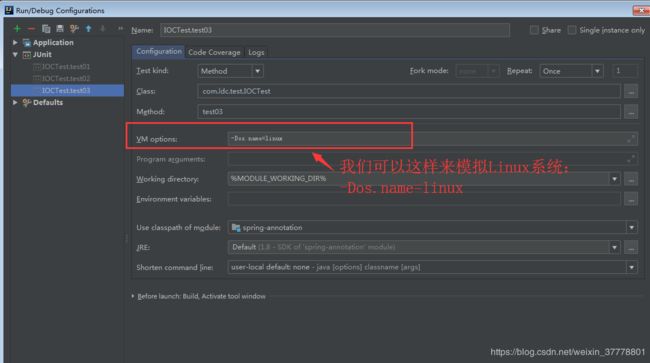
这个时候,我们再来运行测试类方法,结果如下:
linux
linus
Person{name=‘linus’, age=48}
实际上,在这个条件类里面,我们还可以做很多的事情:比如说可以判断容器中bean的注册情况,也可以给容器中注册bean
/**
* 判断操作系统是否为Linux系统
*/
public class LinuxCondition implements Condition {
/**
* ConditionContext : 判断条件能使用的上下文(环境)
* AnnotatedTypeMetadata : 注释信息
* @return
*/
@Override
public boolean matches(ConditionContext context, AnnotatedTypeMetadata metadata) {
//判断是否为Linux系统
//1.能获取到IOC容器里面的BeanFactory
ConfigurableListableBeanFactory beanFactory = context.getBeanFactory();
//2.获取类加载器
ClassLoader classLoader = context.getClassLoader();
//3.能获取当前环境的信息
Environment environment = context.getEnvironment();
//4.获取到bean定义的注册类
BeanDefinitionRegistry registry = context.getRegistry();
//获取操作系统
String property = environment.getProperty("os.name");
//可以判断容器中bean的注册情况,也可以给容器中注册bean
boolean definition = registry.containsBeanDefinition("person");
if (property.contains("linux")) {
return true;
}
return false;
}
}
@Conditional 的这个注解还可以标注在类上,对容器中的组件进行统一设置:满足当前条件,这个类中配置的所有bean注册才能生效
@Configuration
//满足当前条件,这个类中配置的所有bean注册才能生效
@Conditional({WindowsCondition.class})
public class MainConfig2 {
/**
* @Conditional:是SpringBoot底层大量使用的注解,按照一定的条件来进行判断,满足条件 给容器注册bean
*/
/**
* 现在下面的两个bean注册到IOC容器是要条件的:
* 1.如果系统是windows,给容器注册("bill")
* 1.如果系统是linux,给容器注册("linus")
* @return
*/
@Bean("bill")
public Person person01() {
return new Person("Bill Gates",62);
}
@Conditional({LinuxCondition.class})
@Bean("linus")
public Person person02() {
return new Person("linus",48);
}
}
现在的运行结果如下:一个bean都没有, 只打印的一个操作系统的值
linux
组件注册-@Import-给容器中快速导入一个组件
我们先写上一个类:
public class Color {
}
当我们没有添加@Import注解的时候:我们打印容器里面所有的组件
@Test
public void test4() {
ApplicationContext applicationContext = new AnnotationConfigApplicationContext(MainConfig2.class);
printBeans(applicationContext);
}
private void printBeans(ApplicationContext applicationContext) {
String[] definitionNames = applicationContext.getBeanDefinitionNames();
for (String name : definitionNames) {
System.out.println(name);
}
}
这个时候,是没有Color 的这个bean在IOC容器里面
org.springframework.context.annotation.internalConfigurationAnnotationProcessor
org.springframework.context.annotation.internalAutowiredAnnotationProcessor
org.springframework.context.annotation.internalRequiredAnnotationProcessor
org.springframework.context.annotation.internalCommonAnnotationProcessor
org.springframework.context.event.internalEventListenerProcessor
org.springframework.context.event.internalEventListenerFactory
mainConfig2
bill
而当我们使用了 @Import(Color.class)注解之后,我们可以看到IOC容器里面就有这个组件了,id默认就是这个组件的全类名:
@Configuration
//满足当前条件,这个类中配置的所有bean注册才能生效
@Conditional({WindowsCondition.class})
//快速导入组件,id默认是组件的全类名
@Import(Color.class)
public class MainConfig2 {
/**
* @Conditional:是SpringBoot底层大量使用的注解,按照一定的条件来进行判断,满足条件 给容器注册bean
*/
/**
* 现在下面的两个bean注册到IOC容器是要条件的:
* 1.如果系统是windows,给容器注册("bill")
* 1.如果系统是linux,给容器注册("linus")
* @return
*/
@Bean("bill")
public Person person01() {
return new Person("Bill Gates",62);
}
@Conditional({LinuxCondition.class})
@Bean("linus")
public Person person02() {
return new Person("linus",48);
}
/**
* 给容器中注册组件:
* 1)、扫描+组件标注注解(@Controller/@Service/@Repository/@Component)
* 【局限于要求是自己写的类,如果导入的第三方没有添加这些注解,那么就注册不上了】
*
* 2)、@Bean[导入的第三方包里面的组件]
* 3)、@Import[快速的给容器中导入一个组件]
*/
}
我们可以看到现在 IOC 容器有这个com.ldc.bean.Color的这个bean的实例了:
org.springframework.context.annotation.internalConfigurationAnnotationProcessor
org.springframework.context.annotation.internalAutowiredAnnotationProcessor
org.springframework.context.annotation.internalRequiredAnnotationProcessor
org.springframework.context.annotation.internalCommonAnnotationProcessor
org.springframework.context.event.internalEventListenerProcessor
org.springframework.context.event.internalEventListenerFactory
mainConfig2
com.ldc.bean.Color
bill
@Import这个注解也是可以导入多个组件的:
@Target(ElementType.TYPE)
@Retention(RetentionPolicy.RUNTIME)
@Documented
public @interface Import {
/**
* {@link Configuration}, {@link ImportSelector}, {@link ImportBeanDefinitionRegistrar}
* or regular component classes to import.
*/
Class<?>[] value();
}
这个时候,我们可以再来写上一个Red类:
public class Red {
}
我们就可以这样用一个数组来导入多个组件:
@Configuration
//满足当前条件,这个类中配置的所有bean注册才能生效
@Conditional({WindowsCondition.class})
//快速导入组件,id默认是组件的全类名
@Import({Color.class,Red.class})
public class MainConfig2 {
/**
* @Conditional:是SpringBoot底层大量使用的注解,按照一定的条件来进行判断,满足条件 给容器注册bean
*/
/**
* 现在下面的两个bean注册到IOC容器是要条件的:
* 1.如果系统是windows,给容器注册("bill")
* 1.如果系统是linux,给容器注册("linus")
* @return
*/
@Bean("bill")
public Person person01() {
return new Person("Bill Gates",62);
}
@Conditional({LinuxCondition.class})
@Bean("linus")
public Person person02() {
return new Person("linus",48);
}
/**
* 给容器中注册组件:
* 1)、扫描+组件标注注解(@Controller/@Service/@Repository/@Component)
* 【局限于要求是自己写的类,如果导入的第三方没有添加这些注解,那么就注册不上了】
*
* 2)、@Bean[导入的第三方包里面的组件]
* 3)、@Import[快速的给容器中导入一个组件]
*/
}
测试结果:这个时候IOC容器里面就有Color和Red这两个bean的实例了:
org.springframework.context.annotation.internalConfigurationAnnotationProcessor
org.springframework.context.annotation.internalAutowiredAnnotationProcessor
org.springframework.context.annotation.internalRequiredAnnotationProcessor
org.springframework.context.annotation.internalCommonAnnotationProcessor
org.springframework.context.event.internalEventListenerProcessor
org.springframework.context.event.internalEventListenerFactory
mainConfig2
com.ldc.bean.Color
com.ldc.bean.Red
bill
组件注册-@Import-使用ImportSelector
ImportSelector是一个接口:返回需要的组件的全类名的数组;
public interface ImportSelector {
/**
* Select and return the names of which class(es) should be imported based on
* the {@link AnnotationMetadata} of the importing @{@link Configuration} class.
*/
String[] selectImports(AnnotationMetadata importingClassMetadata);
}
现在,我们就来自定义逻辑返回需要导入的组件,需要实现 ImportSelector 这个接口:
//自定义逻辑返回需要导入的组件
public class MyImportSelector implements ImportSelector {
@Override
public String[] selectImports(AnnotationMetadata importingClassMetadata) {
return new String[0];
}
}
现在,我们就可以这样来写:@Import({Color.class,Red.class,MyImportSelector.class})
@Configuration
//满足当前条件,这个类中配置的所有bean注册才能生效
@Conditional({WindowsCondition.class})
//快速导入组件,id默认是组件的全类名
@Import({Color.class,Red.class,MyImportSelector.class})
public class MainConfig2 {
/**
* @Conditional:是SpringBoot底层大量使用的注解,按照一定的条件来进行判断,满足条件 给容器注册bean
*/
/**
* 现在下面的两个bean注册到IOC容器是要条件的:
* 1.如果系统是windows,给容器注册("bill")
* 1.如果系统是linux,给容器注册("linus")
* @return
*/
@Bean("bill")
public Person person01() {
return new Person("Bill Gates",62);
}
@Conditional({LinuxCondition.class})
@Bean("linus")
public Person person02() {
return new Person("linus",48);
}
/**
* 给容器中注册组件:
* 1)、扫描+组件标注注解(@Controller/@Service/@Repository/@Component)
* 【局限于要求是自己写的类,如果导入的第三方没有添加这些注解,那么就注册不上了】
*
* 2)、@Bean[导入的第三方包里面的组件]
* 3)、@Import[快速的给容器中导入一个组件]
* (1)、 @Import(要导入容器中的组件);容器中就会自动的注册这个组件,id默认是全类名
* (2)、 ImportSelector :返回需要的组件的全类名的数组;
*/
}
我们打断点运行这个测试方法:
@Test
public void test4() {
ApplicationContext applicationContext = new AnnotationConfigApplicationContext(MainConfig2.class);
printBeans(applicationContext);
}
private void printBeans(ApplicationContext applicationContext) {
String[] definitionNames = applicationContext.getBeanDefinitionNames();
for (String name : definitionNames) {
System.out.println(name);
}
}
现在,我们再写两个类:
public class Blue {
}
public class Yellow {
}
这个时候,我们就可以这样来在IOC容器里面加入bean,纳入IOC容器的管理:
//自定义逻辑返回需要导入的组件
public class MyImportSelector implements ImportSelector {
//返回值就是要导入到容器中的组件的全类名
//AnnotationMetadata :当前标注@Import注解的类的所有注解信息
@Override
public String[] selectImports(AnnotationMetadata importingClassMetadata) {
//方法不要返回null值
return new String[]{"com.ldc.bean.Blue","com.ldc.bean.Yellow"};
}
}
现在,我们再来运行测试方法,看看IOC容器里面有哪些组件:这个时候Blue和Yellow也就进来了
org.springframework.context.annotation.internalConfigurationAnnotationProcessor
org.springframework.context.annotation.internalAutowiredAnnotationProcessor
org.springframework.context.annotation.internalRequiredAnnotationProcessor
org.springframework.context.annotation.internalCommonAnnotationProcessor
org.springframework.context.event.internalEventListenerProcessor
org.springframework.context.event.internalEventListenerFactory
mainConfig2
com.ldc.bean.Color
com.ldc.bean.Red
com.ldc.bean.Blue
com.ldc.bean.Yellow
bill
组件注册- @Import-使用ImportBeanDefinitionRegistrar
ImportBeanDefinitionRegistrar是一个接口:
public interface ImportBeanDefinitionRegistrar {
/**
* Register bean definitions as necessary based on the given annotation metadata of
* the importing {@code @Configuration} class.
* Note that {@link BeanDefinitionRegistryPostProcessor} types may not be
* registered here, due to lifecycle constraints related to {@code @Configuration}
* class processing.
* @param importingClassMetadata annotation metadata of the importing class
* @param registry current bean definition registry
*/
public void registerBeanDefinitions(
AnnotationMetadata importingClassMetadata, BeanDefinitionRegistry registry);
}
我们可以再定义一个类:
public class RainBow {
}
这个时候,我们就可以自定义一个MyImportBeanDefinitionRegistrar类并且实现ImportBeanDefinitionRegistrar这个接口:
public class MyImportBeanDefinitionRegistrar implements ImportBeanDefinitionRegistrar {
/**
*
* AnnotationMetadata 当前类的注解信息
* BeanDefinitionRegistry BeanDefinition注册类
*
* 我们把所有需要添加到容器中的bean通过BeanDefinitionRegistry里面的registerBeanDefinition方法来手动的进行注册
*/
@Override
public void registerBeanDefinitions(AnnotationMetadata importingClassMetadata, BeanDefinitionRegistry registry) {
//判断IOC容器里面是否含有这两个组件
boolean definition = registry.containsBeanDefinition("com.ldc.bean.Red");
boolean definition2 = registry.containsBeanDefinition("com.ldc.bean.Blue");
//如果有的话,我就把RainBow的bean的实例给注册到IOC容器中
if (definition && definition2) {
//指定bean的定义信息,参数里面指定要注册的bean的类型:RainBow.class
RootBeanDefinition rootBeanDefinition = new RootBeanDefinition(RainBow.class);
//注册一个bean,并且指定bean名
registry.registerBeanDefinition("rainBow", rootBeanDefinition );
}
}
}
同样,我们在@Import的这个注解里面添加我们自定义的MyImportBeanDefinitionRegistrar
@Import({Color.class,Red.class,MyImportSelector.class,MyImportBeanDefinitionRegistrar.class})
@Configuration
//满足当前条件,这个类中配置的所有bean注册才能生效
@Conditional({WindowsCondition.class})
//快速导入组件,id默认是组件的全类名
@Import({Color.class,Red.class,MyImportSelector.class,MyImportBeanDefinitionRegistrar.class})
public class MainConfig2 {
/**
* @Conditional:是SpringBoot底层大量使用的注解,按照一定的条件来进行判断,满足条件 给容器注册bean
*/
/**
* 现在下面的两个bean注册到IOC容器是要条件的:
* 1.如果系统是windows,给容器注册("bill")
* 1.如果系统是linux,给容器注册("linus")
* @return
*/
@Bean("bill")
public Person person01() {
return new Person("Bill Gates",62);
}
@Conditional({LinuxCondition.class})
@Bean("linus")
public Person person02() {
return new Person("linus",48);
}
/**
* 给容器中注册组件:
* 1)、扫描+组件标注注解(@Controller/@Service/@Repository/@Component)
* 【局限于要求是自己写的类,如果导入的第三方没有添加这些注解,那么就注册不上了】
*
* 2)、@Bean[导入的第三方包里面的组件]
* 3)、@Import[快速的给容器中导入一个组件]
* (1)、 @Import(要导入容器中的组件);容器中就会自动的注册这个组件,id默认是全类名
* (2)、 ImportSelector :返回需要的组件的全类名的数组;
* (3)、 ImportBeanDefinitionRegistrar : 手动注册bean到容器中
*/
}
现在,我们来进行测试:
@Test
public void test4() {
ApplicationContext applicationContext = new AnnotationConfigApplicationContext(MainConfig2.class);
printBeans(applicationContext);
}
private void printBeans(ApplicationContext applicationContext) {
String[] definitionNames = applicationContext.getBeanDefinitionNames();
for (String name : definitionNames) {
System.out.println(name);
}
}
测试结果如下:这个时候,我们发现rainBow的这个组件也进来了:
org.springframework.context.annotation.internalConfigurationAnnotationProcessor
org.springframework.context.annotation.internalAutowiredAnnotationProcessor
org.springframework.context.annotation.internalRequiredAnnotationProcessor
org.springframework.context.annotation.internalCommonAnnotationProcessor
org.springframework.context.event.internalEventListenerProcessor
org.springframework.context.event.internalEventListenerFactory
mainConfig2
com.ldc.bean.Color
com.ldc.bean.Red
com.ldc.bean.Blue
com.ldc.bean.Yellow
bill
rainBow
以上就是@Import的三种用法:
- @Import[快速的给容器中导入一个组件]
- (1)、 @Import(要导入容器中的组件);容器中就会自动的注册这个组件,id默认是全类名
- (2)、 ImportSelector :返回需要的组件的全类名的数组;
- (3)、 ImportBeanDefinitionRegistrar : 手动注册bean到容器中
ImportSelector 这种用法在SpringBoot里面用的非常的多;
组件注册-使用FactoryBean注册组件
FactoryBean:
public interface FactoryBean<T> {
/**
* Return an instance (possibly shared or independent) of the object
* managed by this factory.
* As with a {@link BeanFactory}, this allows support for both the
* Singleton and Prototype design pattern.
*
If this FactoryBean is not fully initialized yet at the time of
* the call (for example because it is involved in a circular reference),
* throw a corresponding {@link FactoryBeanNotInitializedException}.
*
As of Spring 2.0, FactoryBeans are allowed to return {@code null}
* objects. The factory will consider this as normal value to be used; it
* will not throw a FactoryBeanNotInitializedException in this case anymore.
* FactoryBean implementations are encouraged to throw
* FactoryBeanNotInitializedException themselves now, as appropriate.
* @return an instance of the bean (can be {@code null})
* @throws Exception in case of creation errors
* @see FactoryBeanNotInitializedException
*/
T getObject() throws Exception;
/**
* Return the type of object that this FactoryBean creates,
* or {@code null} if not known in advance.
* This allows one to check for specific types of beans without
* instantiating objects, for example on autowiring.
*
In the case of implementations that are creating a singleton object,
* this method should try to avoid singleton creation as far as possible;
* it should rather estimate the type in advance.
* For prototypes, returning a meaningful type here is advisable too.
*
This method can be called before this FactoryBean has
* been fully initialized. It must not rely on state created during
* initialization; of course, it can still use such state if available.
*
NOTE: Autowiring will simply ignore FactoryBeans that return
* {@code null} here. Therefore it is highly recommended to implement
* this method properly, using the current state of the FactoryBean.
* @return the type of object that this FactoryBean creates,
* or {@code null} if not known at the time of the call
* @see ListableBeanFactory#getBeansOfType
*/
Class<?> getObjectType();
/**
* Is the object managed by this factory a singleton? That is,
* will {@link #getObject()} always return the same object
* (a reference that can be cached)?
* NOTE: If a FactoryBean indicates to hold a singleton object,
* the object returned from {@code getObject()} might get cached
* by the owning BeanFactory. Hence, do not return {@code true}
* unless the FactoryBean always exposes the same reference.
*
The singleton status of the FactoryBean itself will generally
* be provided by the owning BeanFactory; usually, it has to be
* defined as singleton there.
*
NOTE: This method returning {@code false} does not
* necessarily indicate that returned objects are independent instances.
* An implementation of the extended {@link SmartFactoryBean} interface
* may explicitly indicate independent instances through its
* {@link SmartFactoryBean#isPrototype()} method. Plain {@link FactoryBean}
* implementations which do not implement this extended interface are
* simply assumed to always return independent instances if the
* {@code isSingleton()} implementation returns {@code false}.
* @return whether the exposed object is a singleton
* @see #getObject()
* @see SmartFactoryBean#isPrototype()
*/
boolean isSingleton();
}
首先,我们创建一个类,并且实现 FactoryBean 接口:
//创建一个Spring定义的FactoryBean
public class ColorFactoryBean implements FactoryBean<Color> {
//返回一个Color对象,这个对象会添加到容器中
@Override
public Color getObject() throws Exception {
System.out.println("ColorFactoryBean...getBean...");
return new Color();
}
//返回的类型
@Override
public Class<?> getObjectType() {
return Color.class;
}
//控制是否为单例
// true:表示的就是一个单实例,在容器中保存一份
// false:多实例,每次获取都会创建一个新的bean
@Override
public boolean isSingleton() {
return true;
}
}
这个时候,我们在配置类里面进行配置:可以看到表面上我们装配的是ColorFactoryBean这个类型,但是实际上我们装配的是Color这个bean的实例:
@Configuration
//满足当前条件,这个类中配置的所有bean注册才能生效
@Conditional({WindowsCondition.class})
//快速导入组件,id默认是组件的全类名
@Import({Color.class,Red.class,MyImportSelector.class,MyImportBeanDefinitionRegistrar.class})
public class MainConfig2 {
/**
* @Conditional:是SpringBoot底层大量使用的注解,按照一定的条件来进行判断,满足条件 给容器注册bean
*/
/**
* 现在下面的两个bean注册到IOC容器是要条件的:
* 1.如果系统是windows,给容器注册("bill")
* 1.如果系统是linux,给容器注册("linus")
* @return
*/
@Bean("bill")
public Person person01() {
return new Person("Bill Gates",62);
}
@Conditional({LinuxCondition.class})
@Bean("linus")
public Person person02() {
return new Person("linus",48);
}
/**
* 给容器中注册组件:
* 1)、扫描+组件标注注解(@Controller/@Service/@Repository/@Component)
* 【局限于要求是自己写的类,如果导入的第三方没有添加这些注解,那么就注册不上了】
*
* 2)、@Bean[导入的第三方包里面的组件]
* 3)、@Import[快速的给容器中导入一个组件]
* (1)、 @Import(要导入容器中的组件);容器中就会自动的注册这个组件,id默认是全类名
* (2)、 ImportSelector :返回需要的组件的全类名的数组;
* (3)、 ImportBeanDefinitionRegistrar : 手动注册bean到容器中
*
* 4)、使用Spring提供的FactoryBean(工厂bean)
* (1)、默认获取到的是工厂bean调用getObject创建的对象
* (2)、要获取工厂bean本身,我们需要给id前面加上一个“&”符号:&colorFactoryBean
*/
@Bean
public ColorFactoryBean colorFactoryBean() {
return new ColorFactoryBean();
}
}
最后,我们来进行测试:
@Test
public void test4() {
ApplicationContext applicationContext = new AnnotationConfigApplicationContext(MainConfig2.class);
printBeans(applicationContext);
Object colorFactoryBean = applicationContext.getBean("colorFactoryBean");
System.out.println("bean的类型:"+colorFactoryBean.getClass());
}
private void printBeans(ApplicationContext applicationContext) {
String[] definitionNames = applicationContext.getBeanDefinitionNames();
for (String name : definitionNames) {
System.out.println(name);
}
}
测试结果为:
org.springframework.context.annotation.internalConfigurationAnnotationProcessor
org.springframework.context.annotation.internalAutowiredAnnotationProcessor
org.springframework.context.annotation.internalRequiredAnnotationProcessor
org.springframework.context.annotation.internalCommonAnnotationProcessor
org.springframework.context.event.internalEventListenerProcessor
org.springframework.context.event.internalEventListenerFactory
mainConfig2
com.ldc.bean.Color
com.ldc.bean.Red
com.ldc.bean.Blue
com.ldc.bean.Yellow
bill
colorFactoryBean
rainBow
ColorFactoryBean…getBean…
bean的类型:class com.ldc.bean.Color
如果我们就想要获取这个工厂bean,我们就可以在id的前面加上一个"&"符号
@Test
public void test4() {
ApplicationContext applicationContext = new AnnotationConfigApplicationContext(MainConfig2.class);
printBeans(applicationContext);
//工厂bean获取的是调用getObject方法创建的对象
Object colorFactoryBean = applicationContext.getBean("colorFactoryBean");
System.out.println("bean的类型:"+colorFactoryBean.getClass());
//如果我们就想要获取这个工厂bean,我们就可以在id的前面加上一个"&"符号
Object colorFactoryBean2 = applicationContext.getBean("&colorFactoryBean");
System.out.println("bean的类型:"+colorFactoryBean2.getClass());
}
private void printBeans(ApplicationContext applicationContext) {
String[] definitionNames = applicationContext.getBeanDefinitionNames();
for (String name : definitionNames) {
System.out.println(name);
}
}
测试结果:
org.springframework.context.annotation.internalConfigurationAnnotationProcessor
org.springframework.context.annotation.internalAutowiredAnnotationProcessor
org.springframework.context.annotation.internalRequiredAnnotationProcessor
org.springframework.context.annotation.internalCommonAnnotationProcessor
org.springframework.context.event.internalEventListenerProcessor
org.springframework.context.event.internalEventListenerFactory
mainConfig2
com.ldc.bean.Color
com.ldc.bean.Red
com.ldc.bean.Blue
com.ldc.bean.Yellow
bill
colorFactoryBean
rainBow
ColorFactoryBean…getBean…
colorFactoryBean的类型:class com.ldc.bean.Color
colorFactoryBean2的类型:class com.ldc.bean.ColorFactoryBean
生命周期-@Bean指定初始化和销毁方法
首先,我们有一个Car类:
public class Car {
public Car() {
System.out.println("car constructor...");
}
public void init() {
System.out.println("car...init...");
}
public void destroy() {
System.out.println("car...destroy...");
}
}
有一个配置类:
/**
* bean的生命周期:bean的创建->初始化->销毁的过程
* 容器管理bean的生命周期:
* 我们可以自定义初始化方法和销毁的方法:容器在bean进行到当前的生命周期的时候,来调用我们自定义的初始化方法和销毁方法
* 构造(对象创建):
* 单实例:在容器启动的时候创建对象
* 多实例:在每次获取的时候来创建对象
* 初始化方法:
* 对象创建完成,并赋值好,调用初始化方法
* 销毁方法:
* 单实例的bean:在容器关闭的时候进行销毁
* 多实例的bean:容器不会管理这个bean,容器不会调用销毁的方法
*
* 1)指定初始化方法和销毁方法;
* -我们可以通过@Bean(initMethod = "init",destroyMethod = "destroy")来指定初始化方法和销毁方法
* 相当于xml配置文件bean标签里面的 init-method="" 和 destroy-method="" 属性
*
*
*
*/
@Configuration
public class MainConfigOfLifeCycle {
@Bean(initMethod = "init",destroyMethod = "destroy")
public Car car() {
return new Car();
}
}
我们再来写一个测试方法:
@Test
public void test01() {
//1.创建IOC容器
AnnotationConfigApplicationContext applicationContext = new AnnotationConfigApplicationContext(MainConfigOfLifeCycle.class);
System.out.println("容器创建完成");
}
此时,还没有关闭IOC容器的时候,运行结果为:
car constructor…
car…init…
容器创建完成
而当我们调用了容器的close方法关闭容器的时候:
@Test
public void test01() {
//1.创建IOC容器
AnnotationConfigApplicationContext applicationContext = new AnnotationConfigApplicationContext(MainConfigOfLifeCycle.class);
System.out.println("容器创建完成");
applicationContext.close();
}
测试的运行结果为:
car constructor…
car…init…
容器创建完成
car…destroy…
而当bean的作用域为多例的时候:
@Configuration
public class MainConfigOfLifeCycle {
@Scope("prototype")
@Bean(initMethod = "init",destroyMethod = "destroy")
public Car car() {
return new Car();
}
}
这个时候,我们再来运行这个测试方法:
@Test
public void test01() {
//1.创建IOC容器
AnnotationConfigApplicationContext applicationContext = new AnnotationConfigApplicationContext(MainConfigOfLifeCycle.class);
System.out.println("容器创建完成");
applicationContext.close();
}
运行结果为:
容器创建完成
当bean的作用域为多例的时候,只有在获取的时候,才会创建对象,而且在IOC容器关闭的时候,是不进行销毁的 :
@Test
public void test01() {
//1.创建IOC容器
AnnotationConfigApplicationContext applicationContext = new AnnotationConfigApplicationContext(MainConfigOfLifeCycle.class);
System.out.println("容器创建完成");
applicationContext.getBean("car");
applicationContext.close();
}
此时,运行结果为:
容器创建完成
car constructor…
car…init…
生命周期-InitializingBean和DisposableBean
InitializingBean接口:在bean的初始化方法调用之后进行调用
public interface InitializingBean {
/**
* Invoked by a BeanFactory after it has set all bean properties supplied
* (and satisfied BeanFactoryAware and ApplicationContextAware).
* This method allows the bean instance to perform initialization only
* possible when all bean properties have been set and to throw an
* exception in the event of misconfiguration.
* @throws Exception in the event of misconfiguration (such
* as failure to set an essential property) or if initialization fails.
*/
void afterPropertiesSet() throws Exception;
}
DisposableBean接口:
public interface DisposableBean {
/**
* Invoked by a BeanFactory on destruction of a singleton.
* @throws Exception in case of shutdown errors.
* Exceptions will get logged but not rethrown to allow
* other beans to release their resources too.
*/
void destroy() throws Exception;
}
有一个cat类:实现这两个接口
@Component
public class Cat implements InitializingBean, DisposableBean {
public Cat() {
System.out.println("Cat...Contrustor...");
}
@Override
public void destroy() throws Exception {
System.out.println("Cat...destroy...");
}
@Override
public void afterPropertiesSet() throws Exception {
System.out.println("Cat...afterPropertiesSet...");
}
}
这次,我们就用包扫描的方式来进行装配:
/**
* bean的生命周期:bean的创建->初始化->销毁的过程
* 容器管理bean的生命周期:
* 我们可以自定义初始化方法和销毁的方法:容器在bean进行到当前的生命周期的时候,来调用我们自定义的初始化方法和销毁方法
* 构造(对象创建):
* 单实例:在容器启动的时候创建对象
* 多实例:在每次获取的时候来创建对象
* 初始化方法:
* 对象创建完成,并赋值好,调用初始化方法
* 销毁方法:
* 单实例的bean:在容器关闭的时候进行销毁
* 多实例的bean:容器不会管理这个bean,容器不会调用销毁的方法
*
* 1)指定初始化方法和销毁方法;
* -我们可以通过@Bean(initMethod = "init",destroyMethod = "destroy")来指定初始化方法和销毁方法
* 相当于xml配置文件bean标签里面的 init-method="" 和 destroy-method="" 属性
* 2)通过bean实现InitializingBean(定义初始化逻辑)
* DisposableBean(定义销毁逻辑);
*
*
*/
@Configuration
@ComponentScan("com.ldc.bean")
public class MainConfigOfLifeCycle {
@Bean(initMethod = "init",destroyMethod = "destroy")
public Car car() {
return new Car();
}
}
测试:
@Test
public void test01() {
//1.创建IOC容器
AnnotationConfigApplicationContext applicationContext = new AnnotationConfigApplicationContext(MainConfigOfLifeCycle.class);
System.out.println("容器创建完成");
applicationContext.close();
}
运行结果:
Cat…Contrustor…
Cat…afterPropertiesSet…
car constructor…
car…init…
容器创建完成
car…destroy…
Cat…destroy…
生命周期- @PostConstruct&@PreDestroy
- 3)可以使用JSR250规范里面定义的两个注解:
- @PostConstruct :在bean创建完成并且属性赋值完成,来执行初始化方法
- @PreDestroy :在容器销毁bean之前通知我们来进行清理工作
@PostConstruct:在bean创建完成并且属性赋值完成,来执行初始化方法
@Documented
@Retention (RUNTIME)
@Target(METHOD)
public @interface PostConstruct {
}
@PreDestroy:在容器销毁bean之前通知我们来进行清理工作
@Documented
@Retention (RUNTIME)
@Target(METHOD)
public @interface PreDestroy {
}
我们再来定义一个Dog类:
@Component
public class Dog {
public Dog() {
System.out.println("Dog...Contructor...");
}
//在对象创建并赋值之后调用
@PostConstruct
public void init() {
System.out.println("Dog...@PostConstruct...");
}
//在对象创建并赋值之后调用
@PreDestroy
public void destroy() {
System.out.println("Dog...@PreDestroy...");
}
}
我们再来运行这个测试方法:
@Test
public void test01() {
//1.创建IOC容器
AnnotationConfigApplicationContext applicationContext = new AnnotationConfigApplicationContext(MainConfigOfLifeCycle.class);
System.out.println("容器创建完成");
applicationContext.close();
}
测试结果如下:
Cat…Contrustor…
Cat…afterPropertiesSet…
Dog…Contructor…
Dog…@PostConstruct…
car constructor…
car…init…
容器创建完成
car…destroy…
Dog…@PreDestroy…
Cat…destroy…
生命周期-BeanPostProcessor-后置处理器
- 4)BeanPostProcessor接口:bean的后置处理器,在bean初始化前后做一些处理工作,这个接口有两个方法:
- postProcessBeforeInitialization:在初始化之前工作
- postProcessAfterInitialization:在初始化之后工作
BeanPostProcessor接口:
public interface BeanPostProcessor {
/**
* Apply this BeanPostProcessor to the given new bean instance before any bean
* initialization callbacks (like InitializingBean's {@code afterPropertiesSet}
* or a custom init-method). The bean will already be populated with property values.
* The returned bean instance may be a wrapper around the original.
* @param bean the new bean instance
* @param beanName the name of the bean
* @return the bean instance to use, either the original or a wrapped one;
* if {@code null}, no subsequent BeanPostProcessors will be invoked
* @throws org.springframework.beans.BeansException in case of errors
* @see org.springframework.beans.factory.InitializingBean#afterPropertiesSet
*/
Object postProcessBeforeInitialization(Object bean, String beanName) throws BeansException;
/**
* Apply this BeanPostProcessor to the given new bean instance after any bean
* initialization callbacks (like InitializingBean's {@code afterPropertiesSet}
* or a custom init-method). The bean will already be populated with property values.
* The returned bean instance may be a wrapper around the original.
* In case of a FactoryBean, this callback will be invoked for both the FactoryBean
* instance and the objects created by the FactoryBean (as of Spring 2.0). The
* post-processor can decide whether to apply to either the FactoryBean or created
* objects or both through corresponding {@code bean instanceof FactoryBean} checks.
*
This callback will also be invoked after a short-circuiting triggered by a
* {@link InstantiationAwareBeanPostProcessor#postProcessBeforeInstantiation} method,
* in contrast to all other BeanPostProcessor callbacks.
* @param bean the new bean instance
* @param beanName the name of the bean
* @return the bean instance to use, either the original or a wrapped one;
* if {@code null}, no subsequent BeanPostProcessors will be invoked
* @throws org.springframework.beans.BeansException in case of errors
* @see org.springframework.beans.factory.InitializingBean#afterPropertiesSet
* @see org.springframework.beans.factory.FactoryBean
*/
Object postProcessAfterInitialization(Object bean, String beanName) throws BeansException;
}
同样,还是使用包扫描的方式来进行装配:
/**
* bean的生命周期:bean的创建->初始化->销毁的过程
* 容器管理bean的生命周期:
* 我们可以自定义初始化方法和销毁的方法:容器在bean进行到当前的生命周期的时候,来调用我们自定义的初始化方法和销毁方法
* 构造(对象创建):
* 单实例:在容器启动的时候创建对象
* 多实例:在每次获取的时候来创建对象
* 初始化方法:
* 对象创建完成,并赋值好,调用初始化方法
* 销毁方法:
* 单实例的bean:在容器关闭的时候进行销毁
* 多实例的bean:容器不会管理这个bean,容器不会调用销毁的方法
*
* 1)指定初始化方法和销毁方法;
* -我们可以通过@Bean(initMethod = "init",destroyMethod = "destroy")来指定初始化方法和销毁方法
* 相当于xml配置文件bean标签里面的 init-method="" 和 destroy-method="" 属性
* 2)通过bean实现InitializingBean(定义初始化逻辑)
* DisposableBean(定义销毁逻辑);
*
* 3)可以使用JSR250规范里面定义的两个注解:
* @PostConstruct :在bean创建完成并且属性赋值完成,来执行初始化方法
* @PreDestroy :在容器销毁bean之前通知我们来进行清理工作
* 4)BeanPostProcessor接口:bean的后置处理器
* 在bean初始化前后做一些处理工作,这个接口有两个方法:
* - postProcessBeforeInitialization:在初始化之前工作
* - postProcessAfterInitialization:在初始化之后工作
*/
@Configuration
@ComponentScan("com.ldc.bean")
public class MainConfigOfLifeCycle {
@Bean(initMethod = "init",destroyMethod = "destroy")
public Car car() {
return new Car();
}
}
我们来写一个类并且实现这个后置处理器接口 BeanPostProcessor :
@Component
public class MyBeanPostProcessor implements BeanPostProcessor {
@Override
public Object postProcessBeforeInitialization(Object bean, String beanName) throws BeansException {
System.out.println("postProcessBeforeInitialization..."+beanName+"=>"+bean);
return bean;
}
@Override
public Object postProcessAfterInitialization(Object bean, String beanName) throws BeansException {
System.out.println("postProcessAfterInitialization..."+beanName+"=>"+bean);
return bean;
}
}
此时,我们再来运行这个测试方法:
@Test
public void test01() {
//1.创建IOC容器
AnnotationConfigApplicationContext applicationContext = new AnnotationConfigApplicationContext(MainConfigOfLifeCycle.class);
System.out.println("容器创建完成");
applicationContext.close();
}
运行结果如下:
postProcessBeforeInitialization…org.springframework.context.event.internalEventListenerProcessor=>org.springframework.context.event.EventListenerMethodProcessor@36f0f1be
postProcessAfterInitialization…org.springframework.context.event.internalEventListenerProcessor=>org.springframework.context.event.EventListenerMethodProcessor@36f0f1be
postProcessBeforeInitialization…org.springframework.context.event.internalEventListenerFactory=>org.springframework.context.event.DefaultEventListenerFactory@6ee12bac
postProcessAfterInitialization…org.springframework.context.event.internalEventListenerFactory=>org.springframework.context.event.DefaultEventListenerFactory@6ee12bac
postProcessBeforeInitialization…mainConfigOfLifeCycle=>com.ldc.config.MainConfigOfLifeCycle E n h a n c e r B y S p r i n g C G L I B EnhancerBySpringCGLIB EnhancerBySpringCGLIB27d6c7d3@64c87930
postProcessAfterInitialization…mainConfigOfLifeCycle=>com.ldc.config.MainConfigOfLifeCycle E n h a n c e r B y S p r i n g C G L I B EnhancerBySpringCGLIB EnhancerBySpringCGLIB27d6c7d3@64c87930
Cat…Contrustor…
postProcessBeforeInitialization…cat=>com.ldc.bean.Cat@525f1e4e
Cat…afterPropertiesSet…
postProcessAfterInitialization…cat=>com.ldc.bean.Cat@525f1e4e
Dog…Contructor…
postProcessBeforeInitialization…dog=>com.ldc.bean.Dog@5ea434c8
Dog…@PostConstruct…
postProcessAfterInitialization…dog=>com.ldc.bean.Dog@5ea434c8
car constructor…
postProcessBeforeInitialization…car=>com.ldc.bean.Car@1d548a08
car…init…
postProcessAfterInitialization…car=>com.ldc.bean.Car@1d548a08
容器创建完成
car…destroy…
Dog…@PreDestroy…
Cat…destroy…
生命周期-BeanPostProcessor原理
然后,我们以debug的方式来运行这个测试方法:
@Test
public void test01() {
//1.创建IOC容器
AnnotationConfigApplicationContext applicationContext = new AnnotationConfigApplicationContext(MainConfigOfLifeCycle.class);
System.out.println("容器创建完成");
applicationContext.close();
}
前置处理器调用的方法:调用getBeanPostProcessors()方法找到容器里面的所有的BeanPostProcessor,挨个遍历,调用BeanPostProcessor的postProcessBeforeInitialization方法,一旦调用postProcessBeforeInitialization方法的返回值为null的时候,就直接跳出遍历 ,后面的BeanPostProcessor 的postProcessBeforeInitialization也就不会执行了:
@Override
public Object applyBeanPostProcessorsBeforeInitialization(Object existingBean, String beanName)
throws BeansException {
Object result = existingBean;
for (BeanPostProcessor beanProcessor : getBeanPostProcessors()) {
result = beanProcessor.postProcessBeforeInitialization(result, beanName);
if (result == null) {
return result;
}
}
return result;
}
后置处理器调用的方法:调用getBeanPostProcessors()方法找到容器里面的所有的BeanPostProcessor,挨个遍历,调用BeanPostProcessor的postProcessAfterInitialization方法,一旦调用postProcessAfterInitialization方法的返回值为null的时候,就直接跳出遍历 ,后面的BeanPostProcessor 的postProcessAfterInitialization也就不会执行了:
@Override
public Object applyBeanPostProcessorsAfterInitialization(Object existingBean, String beanName)
throws BeansException {
Object result = existingBean;
for (BeanPostProcessor beanProcessor : getBeanPostProcessors()) {
result = beanProcessor.postProcessAfterInitialization(result, beanName);
if (result == null) {
return result;
}
}
return result;
}
//前置处理器执行
wrappedBean = applyBeanPostProcessorsBeforeInitialization(wrappedBean, beanName);
//初始化方法执行
invokeInitMethods(beanName, wrappedBean, mbd);
//后置处理器执行
wrappedBean = applyBeanPostProcessorsAfterInitialization(wrappedBean, beanName);
在看源码的时候,我们可以发现:
在执行exposedObject = initializeBean(beanName, exposedObject, mbd);方法之前先调用了populateBean(beanName, mbd, instanceWrapper);这个方法:
populateBean(beanName, mbd, instanceWrapper);–给bean进行属性赋值
exposedObject = initializeBean(beanName, exposedObject, mbd);–初始化方法,在这个初始化方法内部包括了前置处理器、初始化方法、后置处理器的调用:
生命周期- BeanPostProcessor在Spring底层的使用
- Spring底层对 BeanPostProcessor 的使用:
- bean赋值,注入其他组件,
@Autowired,生命周期注解等功能,@Async等等都是使用BeanPostProcessor来完成的
- bean赋值,注入其他组件,
BeanPostProcessor 这个接口有很多的实现类:
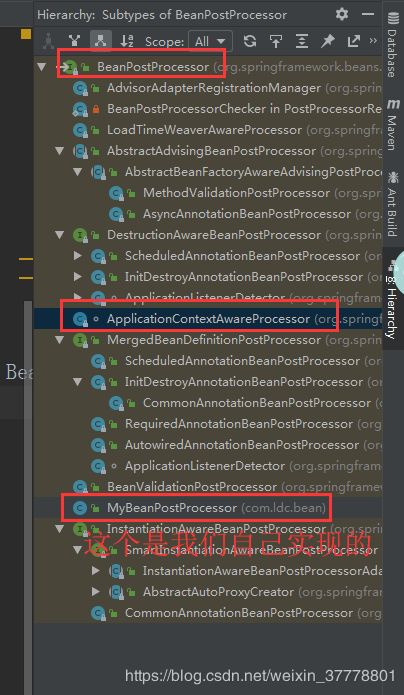
如果我们想要获取IOC容器,我们可以这样做:
@Component
public class Dog implements ApplicationContextAware {
private ApplicationContext applicationContext;
public Dog() {
System.out.println("Dog...Contructor...");
}
//在对象创建并赋值之后调用
@PostConstruct
public void init() {
System.out.println("Dog...@PostConstruct...");
}
//在对象创建并赋值之后调用
@PreDestroy
public void destroy() {
System.out.println("Dog...@PreDestroy...");
}
@Override
public void setApplicationContext(ApplicationContext applicationContext) throws BeansException {
this.applicationContext = applicationContext;
}
}
我们还是debug运行这个测试方法:
@Test
public void test01() {
//1.创建IOC容器
AnnotationConfigApplicationContext applicationContext = new AnnotationConfigApplicationContext(MainConfigOfLifeCycle.class);
System.out.println("容器创建完成");
applicationContext.close();
}
实际上BeanPostProcessor接口还有很多的实现类,比如说BeanValidationPostProcessor,这个是用来做数据校验的:
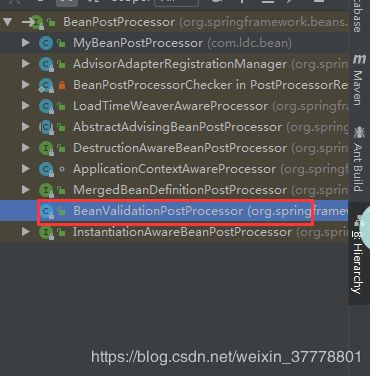
像InitDestroyAnnotationBeanPostProcessor这个实现类就是实现了@PostConstruct和@PreDestroy这两个注解的功能:
